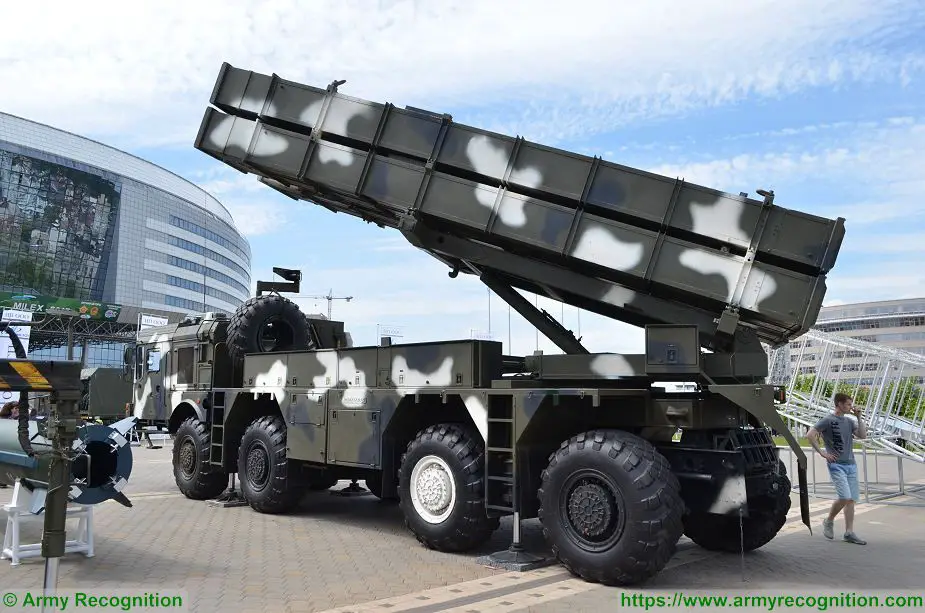Belarus tests upgraded version of Polonez MLRS rocket launcher
Belarus is testing an updated variant of the Polonez multiple launch rocket system (MLRS), Polonez-M (M stands for Upgraded, Modernizirovanny), with a firing range of 299 km, according to the Military-Industrial Complex.VPK.Belarus magazine issued by Belarus' State Military-Industrial Committee (Goskomvoenprom, GKVP)

Belarus Polonez 300mm MLRS Multiple Launch Rocket System at Milex 2017 defense exhibition in Minsk, Belarus (Picture source Army Recognition)
"On October 26, 2017, the modernized variant of the [Polonez] MLRS passed its live-fire trials. The firing range of the system has increased by 50% and reached 299 km," the magazine says, adding that the specified target was hit with 100% accuracy. The modernization works are being carried out by a consortium of Belarusian defense enterprises led by the Precision Electro-Mechanics Plant (ZTEhM).
The V-200 Polonez MLRS was unveiled at the MILEX 2017 exhibition held in Minsk from May 20-22. The system incorporates the V-200BM combat vehicle, the V-200TZM transport-loader and the V-200BMU upgraded command-and-control (C2) vehicle. The specifications of the Polonez were disclosed at the MILEX 2017 show also. The MLRS will get a rocket, which will be able to deliver a 480 kg warhead to a range varying between 120 km and 280 km.
Owing to a low efficient dispersal surface, high precision and high speed, the rocket of the Polonez can beat air defense assets, the representatives of ZTEhM said at the MILEX 2017 exhibition.
In October 2016, the Polonez MLRS was delivered to the 77th Separate Rocket Artillery Battalion of the 336th Rocket Artillery Brigade. In September 2017, the battalion was involved in the Russian-Belarusian Zapad 2017 strategic exercise. In October 2017, the unit carried out the aforementioned firing test of the upgraded Polonez.
The organic V-200 Polonez MLRS has a firing range of 50-200 km and a combat readiness time of nearly 10 minutes. The system is designed to engage C2 posts, communication hubs, airfields, roads and bridges, various pieces of infrastructure, munition and fuel depots, etc. A division of the Polonez MLRS is armed with an ammunition load of 144 rockets.
The V-200BM combat vehicle is armed with eight ready-to-launch 301 mm rockets in two four-cell containers. The vehicle's launching unit is based on an MZKT-7930-family 8x8 wheeled tractor developed by the Minsk Wheeled Tractor Plant (MZKT or Volat). The tractor has a crew of three and a maximum speed of 70 km/h.

The Polonez MLRS can be fitted with rockets and guided missiles. At the MILEX 2017 defense show, the M20 single-stage solid-propellant guided missile for the system was unveiled. According to the official information issued by the Belarusian defense industry, the M20 has a length of nearly 8 m, a weight of nearly 4 t and a firing range of about 280 km. The containerized missile is armed with a 480 kg high-explosive (HE) warhead. According to Belarusian media outlets, the M20 may have been developed in conjunction with the Chinese industry. The missile presented at the MILEX 2017 show dramatically resembles the M20 missile developed by the China Academy of Launch Vehicle Technology (CALT; also known as the First Academy). The Chinese M20 missile armed with a 480 kg HE warhead has a firing range of 280 km. It should be mentioned that the organic rocket of the Polonez MLRS is believed to be based on the A200 system also developed by the Chinese defense industry.
The Belarusian Ministry of Defense (MoD) does not disclose the specifications of the Polonez-M upgraded MLRS. The system is reported to have a firing range of nearly 300 km and a circular error probability (CEP) of no more than 30-45 m (depending on the type of the rocket). The rocket of the updated Polonez can be fitted with a high-explosive fragmentation (HE-Frag), a fragmentation armor-piercing (AP) cluster or a penetrating (concrete-piercing) warhead.
Minsk is planning to localize the manufacturing of the components of the Polonez MLRS to the full extent. "The [Polonez] system is a Belarusian item; however, several components of the rocket are of foreign origination. There is a task to localize the manufacturing of the rocket in Belarus," State Secretary of the Security Council of Belarus Stanislav Zas said in late January. The missile test-fired by the Polonez in last October is reported to have incorporated locally manufactured components.


























